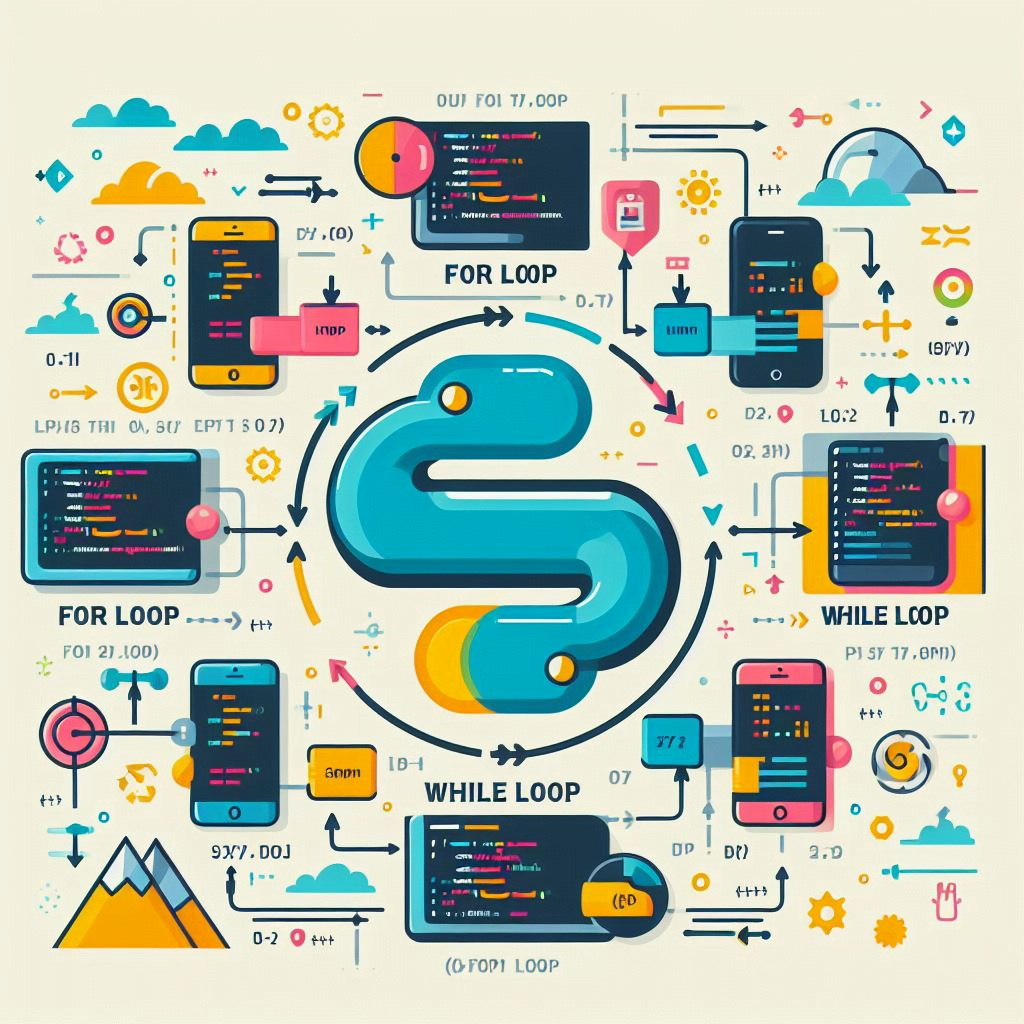Loops in Python: Python, as a versatile programming language, offers a variety of looping mechanisms to iterate over sequences, perform repetitive tasks, and control the flow of execution. Mastering these loops is fundamental for any Python developer. In this comprehensive guide, we’ll explore the two primary types of loops in Python: for and while, providing examples and insights to help you grasp their usage effectively.

Table of Contents
- Introduction to Loops in Python
- for Loop
- while Loop
- Loop Control Statements
- Exercise
- E1. Write a Python program to print all even numbers from 1 to 50 using a for loop.
- E2. Write a Python program to calculate the factorial of a given number using a while loop.
- E3. Write a Python program to print the multiplication table of a given number using a for loop.
- E4. Write a Python program to count the occurrences of each character in a given string.
- E5. Write a Python program to find all prime numbers between 1 and 100.
- E6. Reverse a String
- E7. Write a Python program to implement a countdown timer using a while loop.
- E8. Write a Python program to print odd numbers in reverse order from 20 to 1 using a while loop.
- Conclusion
Introduction to Loops in Python
Loops in Python are used to execute a block of code repeatedly as long as a specified condition is met. They help automate repetitive tasks and are an essential component of any programming language. Let’s dive into the details of each loop type.
for Loop
Iterating over Lists
The for loop iterates over each item in a list.
# Iterating over a list
fruits = ["apple", "banana", "cherry"]
for fruit in fruits:
print(f"I like {fruit}s") Iterating over Strings
The for loop can also iterate over each character in a string.
# Iterating over a string
word = "Python"
for char in word:
print(char)
while Loop
Basic while Loop
The while loop runs a piece of code repeatedly as long as the given condition remains True.
# Basic while loop example
count = 0
while count < 5:
print(f"Count: {count}")
count += 1
Infinite while Loop
An infinite while loop runs indefinitely until stopped manually or until the program is terminated.
# Infinite while loop example
while True:
print("This is an infinite loop!")
choice = input("Enter 'stop' to end the loop: ")
if choice == 'stop':
break
Loop Control Statements
break Statement
The break statement terminates the loop early.
# Using break statement
for i in range(10):
if i == 5:
break
print(i)
continue Statement
The continue statement skips the rest of the loop’s body for the current iteration.
# Using continue statement
for i in range(5):
if i == 2:
continue
print(i)
Exercise
E1. Write a Python program to print all even numbers from 1 to 50 using a for loop.
for num in range(1, 51):
if num % 2 == 0:
print(num)
E2. Write a Python program to calculate the factorial of a given number using a while loop.
num = int(input("Enter a number: "))
factorial = 1
while num > 0:
factorial *= num
num -= 1
print("Factorial:", factorial)
E3. Write a Python program to print the multiplication table of a given number using a for loop.
num = int(input("Enter a number: "))
for i in range(1, 11):
print(num, "x", i, "=", num * i)
E4. Write a Python program to count the occurrences of each character in a given string.
string = "I Love Python Programming Language"
char_count = {}
for char in string:
if char in char_count:
char_count[char] += 1
else:
char_count[char] = 1
print("Character count:", char_count)
E5. Write a Python program to find all prime numbers between 1 and 100.
for num in range(2, 101):
prime = True
for i in range(2, num):
if num % i == 0:
prime = False
break
if prime:
print(num)
E6. Reverse a String
string = input("Enter a string: ")
reversed_string = ""
for char in string:
reversed_string = char + reversed_string
print("Reversed string:", reversed_string)
E7. Write a Python program to implement a countdown timer using a while loop.
import time
seconds = 10
while seconds > 0:
print(seconds)
time.sleep(1)
seconds -= 1
print("Time's up!")
E8. Write a Python program to print odd numbers in reverse order from 20 to 1 using a while loop.
num = 20
while num >= 1:
if num % 2 != 0:
print(num, end=" ")
num -= 1
Conclusion
Understanding the details of loops in Python is crucial for efficient and structured programming. Whether you’re working with for loops for iterating over sequences or while loops for conditional repetition, mastering these constructs will enhance your coding capabilities significantly.
With the knowledge gained from this comprehensive guide, you’re well-equipped to utilize loops effectively in your Python projects. Happy coding!


